display CHEVROLET VOLT 2011 Owner's Manual
[x] Cancel search | Manufacturer: CHEVROLET, Model Year: 2011, Model line: VOLT, Model: CHEVROLET VOLT 2011Pages: 516, PDF Size: 6.61 MB
Page 330 of 516
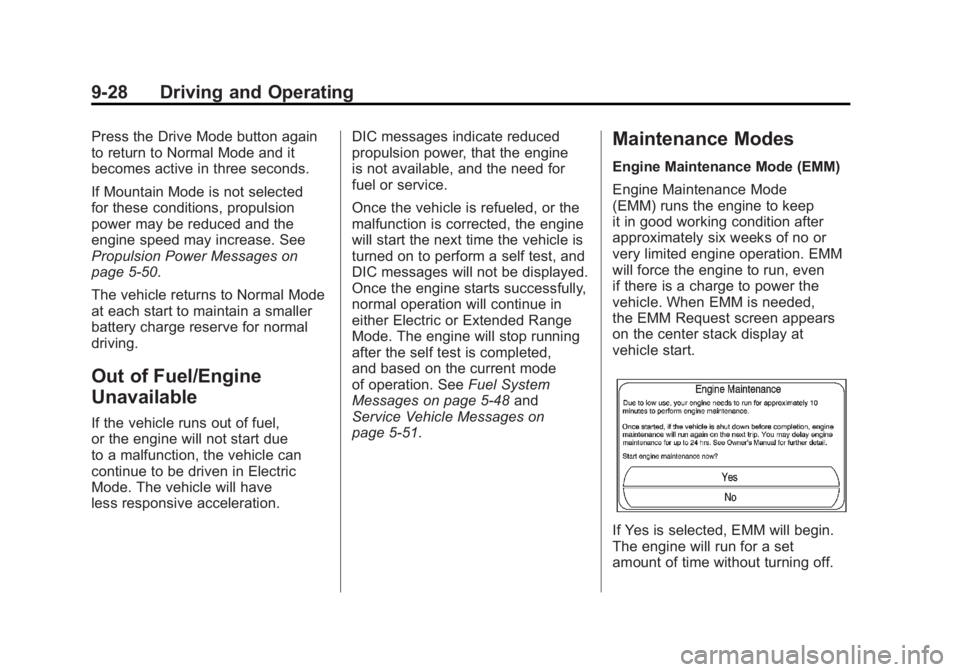
Black plate (28,1)Chevrolet Volt Owner Manual - 2011
9-28 Driving and Operating
Press the Drive Mode button again
to return to Normal Mode and it
becomes active in three seconds.
If Mountain Mode is not selected
for these conditions, propulsion
power may be reduced and the
engine speed may increase. See
Propulsion Power Messages on
page 5‑50.
The vehicle returns to Normal Mode
at each start to maintain a smaller
battery charge reserve for normal
driving.
Out of Fuel/Engine
Unavailable
If the vehicle runs out of fuel,
or the engine will not start due
to a malfunction, the vehicle can
continue to be driven in Electric
Mode. The vehicle will have
less responsive acceleration.DIC messages indicate reduced
propulsion power, that the engine
is not available, and the need for
fuel or service.
Once the vehicle is refueled, or the
malfunction is corrected, the engine
will start the next time the vehicle is
turned on to perform a self test, and
DIC messages will not be displayed.
Once the engine starts successfully,
normal operation will continue in
either Electric or Extended Range
Mode. The engine will stop running
after the self test is completed,
and based on the current mode
of operation. See
Fuel System
Messages on page 5‑48 and
Service Vehicle Messages on
page 5‑51.
Maintenance Modes
Engine Maintenance Mode (EMM)
Engine Maintenance Mode
(EMM) runs the engine to keep
it in good working condition after
approximately six weeks of no or
very limited engine operation. EMM
will force the engine to run, even
if there is a charge to power the
vehicle. When EMM is needed,
the EMM Request screen appears
on the center stack display at
vehicle start.
If Yes is selected, EMM will begin.
The engine will run for a set
amount of time without turning off.
Page 331 of 516
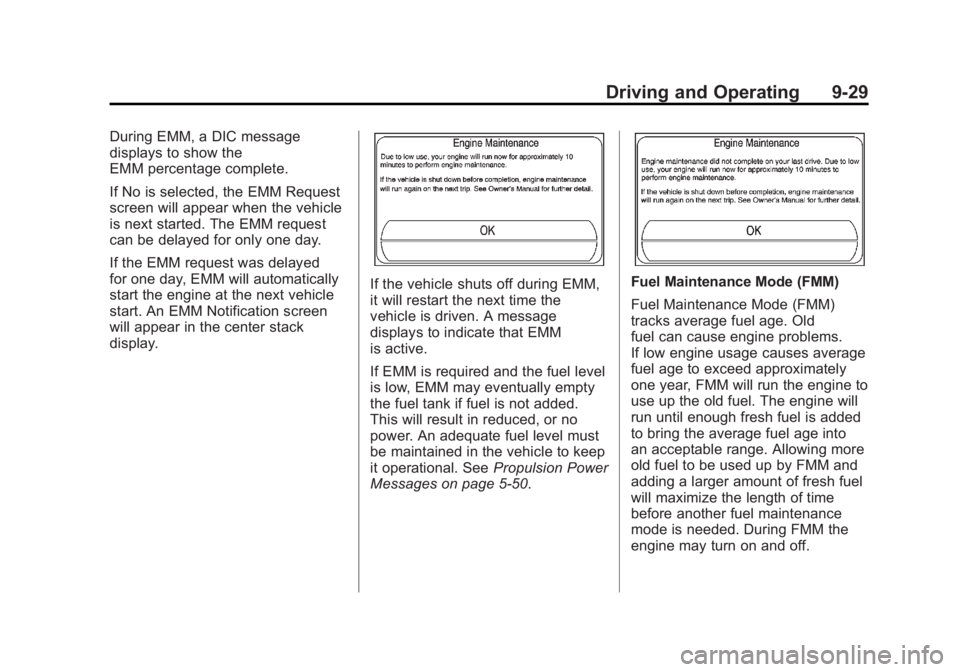
Black plate (29,1)Chevrolet Volt Owner Manual - 2011
Driving and Operating 9-29
During EMM, a DIC message
displays to show the
EMM percentage complete.
If No is selected, the EMM Request
screen will appear when the vehicle
is next started. The EMM request
can be delayed for only one day.
If the EMM request was delayed
for one day, EMM will automatically
start the engine at the next vehicle
start. An EMM Notification screen
will appear in the center stack
display.
If the vehicle shuts off during EMM,
it will restart the next time the
vehicle is driven. A message
displays to indicate that EMM
is active.
If EMM is required and the fuel level
is low, EMM may eventually empty
the fuel tank if fuel is not added.
This will result in reduced, or no
power. An adequate fuel level must
be maintained in the vehicle to keep
it operational. SeePropulsion Power
Messages on page 5‑50.Fuel Maintenance Mode (FMM)
Fuel Maintenance Mode (FMM)
tracks average fuel age. Old
fuel can cause engine problems.
If low engine usage causes average
fuel age to exceed approximately
one year, FMM will run the engine to
use up the old fuel. The engine will
run until enough fresh fuel is added
to bring the average fuel age into
an acceptable range. Allowing more
old fuel to be used up by FMM and
adding a larger amount of fresh fuel
will maximize the length of time
before another fuel maintenance
mode is needed. During FMM the
engine may turn on and off.
Page 332 of 516
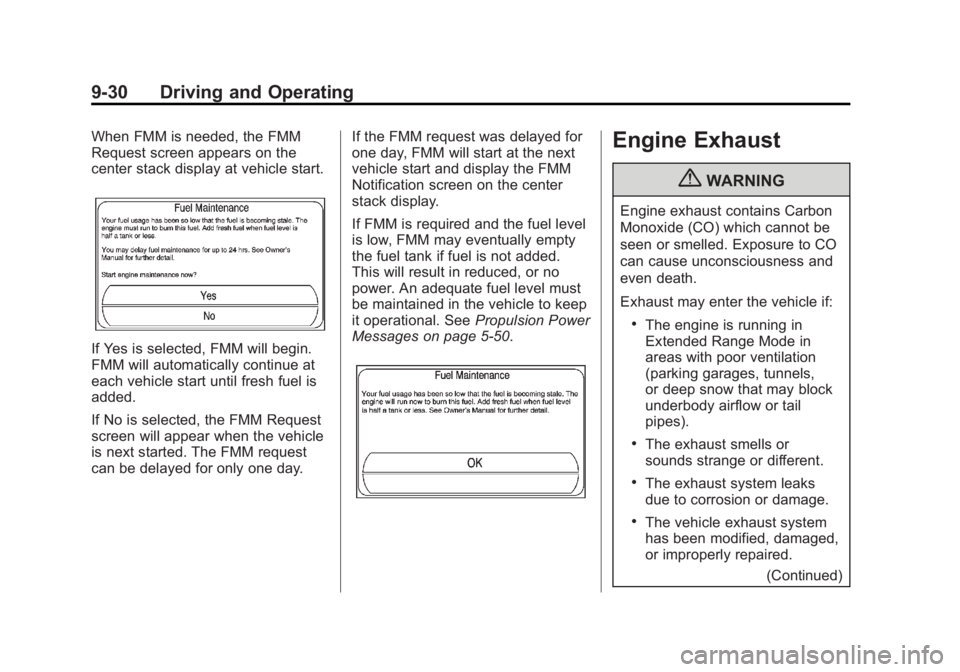
Black plate (30,1)Chevrolet Volt Owner Manual - 2011
9-30 Driving and Operating
When FMM is needed, the FMM
Request screen appears on the
center stack display at vehicle start.
If Yes is selected, FMM will begin.
FMM will automatically continue at
each vehicle start until fresh fuel is
added.
If No is selected, the FMM Request
screen will appear when the vehicle
is next started. The FMM request
can be delayed for only one day.If the FMM request was delayed for
one day, FMM will start at the next
vehicle start and display the FMM
Notification screen on the center
stack display.
If FMM is required and the fuel level
is low, FMM may eventually empty
the fuel tank if fuel is not added.
This will result in reduced, or no
power. An adequate fuel level must
be maintained in the vehicle to keep
it operational. See
Propulsion Power
Messages on page 5‑50.
Engine Exhaust
{WARNING
Engine exhaust contains Carbon
Monoxide (CO) which cannot be
seen or smelled. Exposure to CO
can cause unconsciousness and
even death.
Exhaust may enter the vehicle if:
.The engine is running in
Extended Range Mode in
areas with poor ventilation
(parking garages, tunnels,
or deep snow that may block
underbody airflow or tail
pipes).
.The exhaust smells or
sounds strange or different.
.The exhaust system leaks
due to corrosion or damage.
.The vehicle exhaust system
has been modified, damaged,
or improperly repaired.
(Continued)
Page 337 of 516
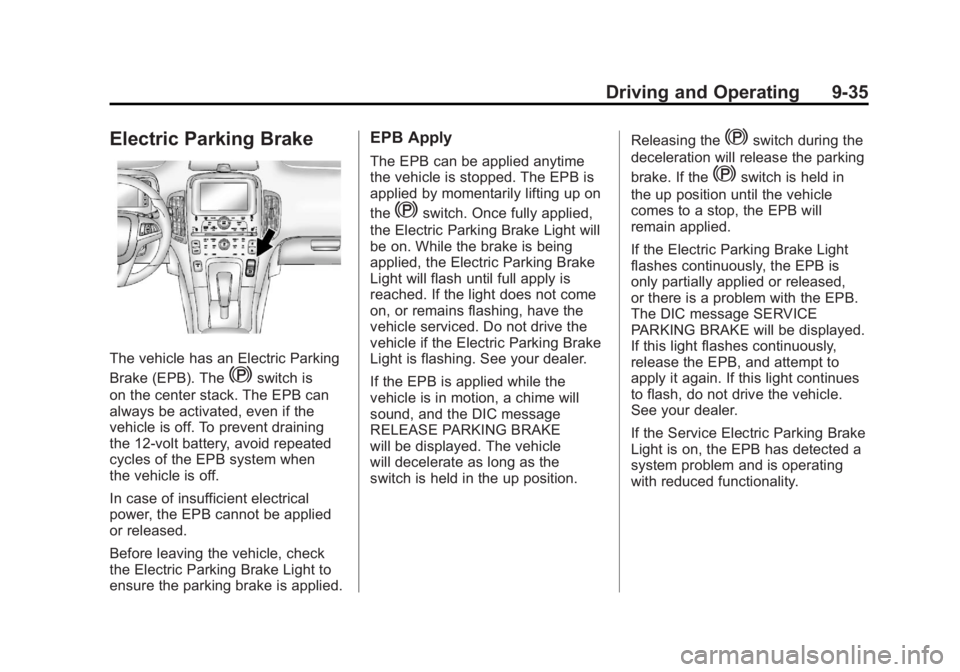
Black plate (35,1)Chevrolet Volt Owner Manual - 2011
Driving and Operating 9-35
Electric Parking Brake
The vehicle has an Electric Parking
Brake (EPB). The
Yswitch is
on the center stack. The EPB can
always be activated, even if the
vehicle is off. To prevent draining
the 12‐volt battery, avoid repeated
cycles of the EPB system when
the vehicle is off.
In case of insufficient electrical
power, the EPB cannot be applied
or released.
Before leaving the vehicle, check
the Electric Parking Brake Light to
ensure the parking brake is applied.
EPB Apply
The EPB can be applied anytime
the vehicle is stopped. The EPB is
applied by momentarily lifting up on
the
Yswitch. Once fully applied,
the Electric Parking Brake Light will
be on. While the brake is being
applied, the Electric Parking Brake
Light will flash until full apply is
reached. If the light does not come
on, or remains flashing, have the
vehicle serviced. Do not drive the
vehicle if the Electric Parking Brake
Light is flashing. See your dealer.
If the EPB is applied while the
vehicle is in motion, a chime will
sound, and the DIC message
RELEASE PARKING BRAKE
will be displayed. The vehicle
will decelerate as long as the
switch is held in the up position. Releasing the
Yswitch during the
deceleration will release the parking
brake. If the
Yswitch is held in
the up position until the vehicle
comes to a stop, the EPB will
remain applied.
If the Electric Parking Brake Light
flashes continuously, the EPB is
only partially applied or released,
or there is a problem with the EPB.
The DIC message SERVICE
PARKING BRAKE will be displayed.
If this light flashes continuously,
release the EPB, and attempt to
apply it again. If this light continues
to flash, do not drive the vehicle.
See your dealer.
If the Service Electric Parking Brake
Light is on, the EPB has detected a
system problem and is operating
with reduced functionality.
Page 338 of 516
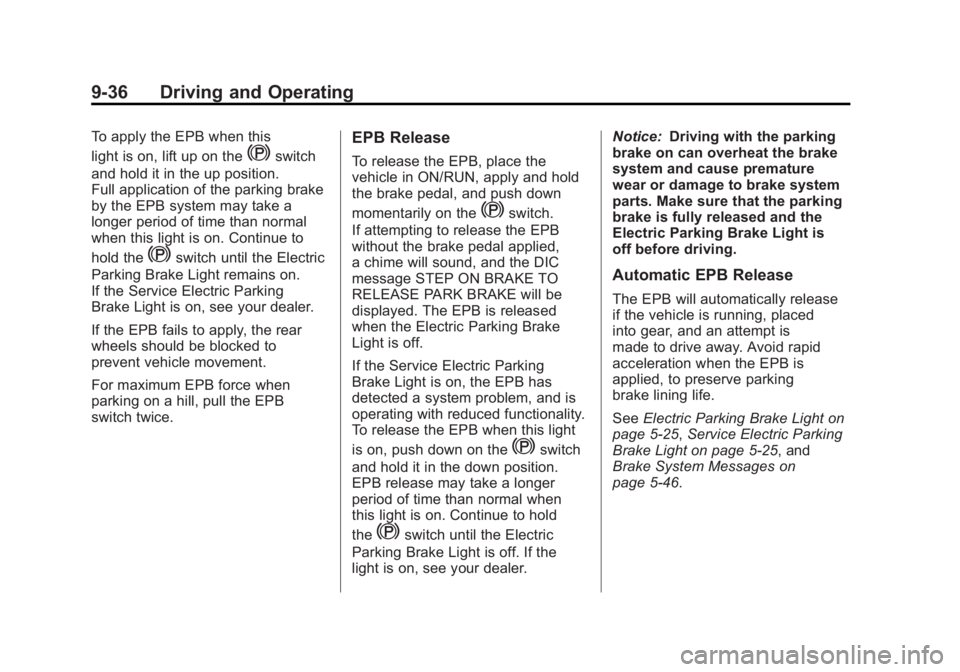
Black plate (36,1)Chevrolet Volt Owner Manual - 2011
9-36 Driving and Operating
To apply the EPB when this
light is on, lift up on the
Yswitch
and hold it in the up position.
Full application of the parking brake
by the EPB system may take a
longer period of time than normal
when this light is on. Continue to
hold the
Yswitch until the Electric
Parking Brake Light remains on.
If the Service Electric Parking
Brake Light is on, see your dealer.
If the EPB fails to apply, the rear
wheels should be blocked to
prevent vehicle movement.
For maximum EPB force when
parking on a hill, pull the EPB
switch twice.
EPB Release
To release the EPB, place the
vehicle in ON/RUN, apply and hold
the brake pedal, and push down
momentarily on the
Yswitch.
If attempting to release the EPB
without the brake pedal applied,
a chime will sound, and the DIC
message STEP ON BRAKE TO
RELEASE PARK BRAKE will be
displayed. The EPB is released
when the Electric Parking Brake
Light is off.
If the Service Electric Parking
Brake Light is on, the EPB has
detected a system problem, and is
operating with reduced functionality.
To release the EPB when this light
is on, push down on the
Yswitch
and hold it in the down position.
EPB release may take a longer
period of time than normal when
this light is on. Continue to hold
the
Yswitch until the Electric
Parking Brake Light is off. If the
light is on, see your dealer. Notice:
Driving with the parking
brake on can overheat the brake
system and cause premature
wear or damage to brake system
parts. Make sure that the parking
brake is fully released and the
Electric Parking Brake Light is
off before driving.
Automatic EPB Release
The EPB will automatically release
if the vehicle is running, placed
into gear, and an attempt is
made to drive away. Avoid rapid
acceleration when the EPB is
applied, to preserve parking
brake lining life.
See Electric Parking Brake Light on
page 5‑25, Service Electric Parking
Brake Light on page 5‑25, and
Brake System Messages on
page 5‑46.
Page 340 of 516
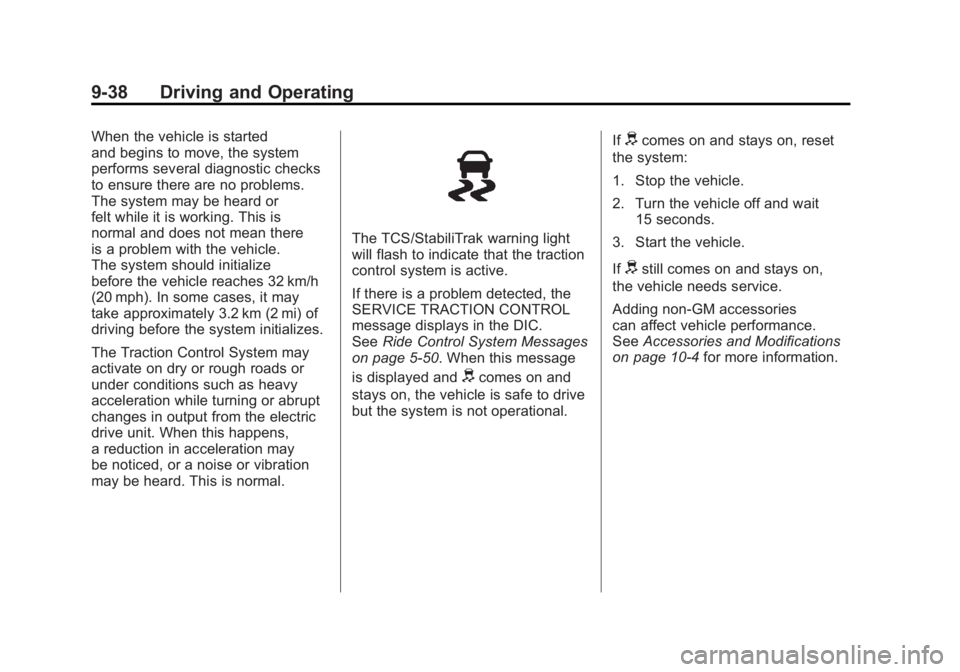
Black plate (38,1)Chevrolet Volt Owner Manual - 2011
9-38 Driving and Operating
When the vehicle is started
and begins to move, the system
performs several diagnostic checks
to ensure there are no problems.
The system may be heard or
felt while it is working. This is
normal and does not mean there
is a problem with the vehicle.
The system should initialize
before the vehicle reaches 32 km/h
(20 mph). In some cases, it may
take approximately 3.2 km (2 mi) of
driving before the system initializes.
The Traction Control System may
activate on dry or rough roads or
under conditions such as heavy
acceleration while turning or abrupt
changes in output from the electric
drive unit. When this happens,
a reduction in acceleration may
be noticed, or a noise or vibration
may be heard. This is normal.
The TCS/StabiliTrak warning light
will flash to indicate that the traction
control system is active.
If there is a problem detected, the
SERVICE TRACTION CONTROL
message displays in the DIC.
SeeRide Control System Messages
on page 5‑50. When this message
is displayed and
dcomes on and
stays on, the vehicle is safe to drive
but the system is not operational. If
dcomes on and stays on, reset
the system:
1. Stop the vehicle.
2. Turn the vehicle off and wait 15 seconds.
3. Start the vehicle.
If
dstill comes on and stays on,
the vehicle needs service.
Adding non‐GM accessories
can affect vehicle performance.
See Accessories and Modifications
on page 10‑4 for more information.
Page 341 of 516
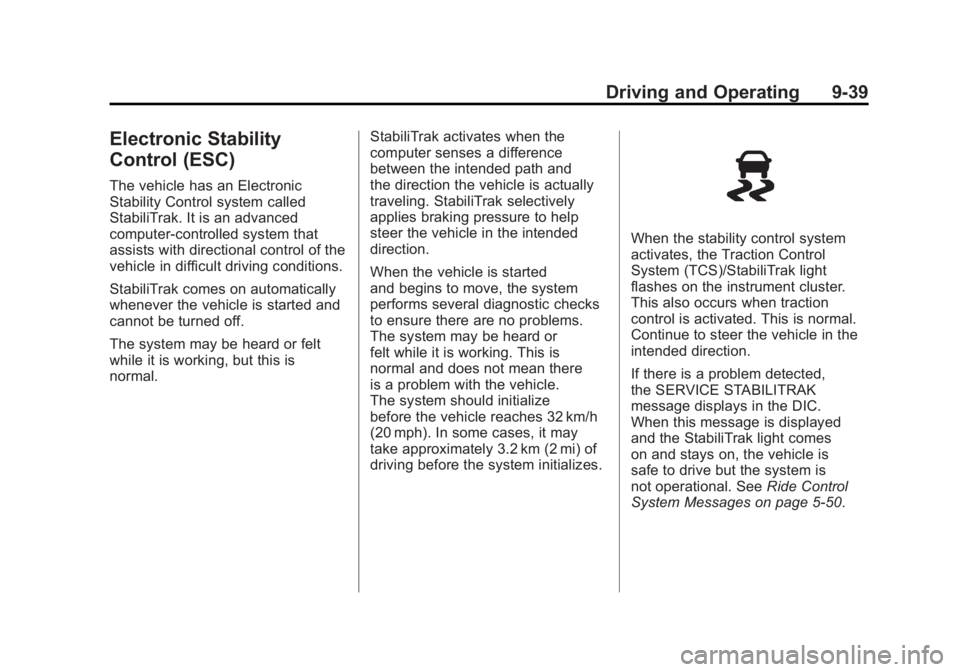
Black plate (39,1)Chevrolet Volt Owner Manual - 2011
Driving and Operating 9-39
Electronic Stability
Control (ESC)
The vehicle has an Electronic
Stability Control system called
StabiliTrak. It is an advanced
computer‐controlled system that
assists with directional control of the
vehicle in difficult driving conditions.
StabiliTrak comes on automatically
whenever the vehicle is started and
cannot be turned off.
The system may be heard or felt
while it is working, but this is
normal.StabiliTrak activates when the
computer senses a difference
between the intended path and
the direction the vehicle is actually
traveling. StabiliTrak selectively
applies braking pressure to help
steer the vehicle in the intended
direction.
When the vehicle is started
and begins to move, the system
performs several diagnostic checks
to ensure there are no problems.
The system may be heard or
felt while it is working. This is
normal and does not mean there
is a problem with the vehicle.
The system should initialize
before the vehicle reaches 32 km/h
(20 mph). In some cases, it may
take approximately 3.2 km (2 mi) of
driving before the system initializes.
When the stability control system
activates, the Traction Control
System (TCS)/StabiliTrak light
flashes on the instrument cluster.
This also occurs when traction
control is activated. This is normal.
Continue to steer the vehicle in the
intended direction.
If there is a problem detected,
the SERVICE STABILITRAK
message displays in the DIC.
When this message is displayed
and the StabiliTrak light comes
on and stays on, the vehicle is
safe to drive but the system is
not operational. See
Ride Control
System Messages on page 5‑50.
Page 346 of 516
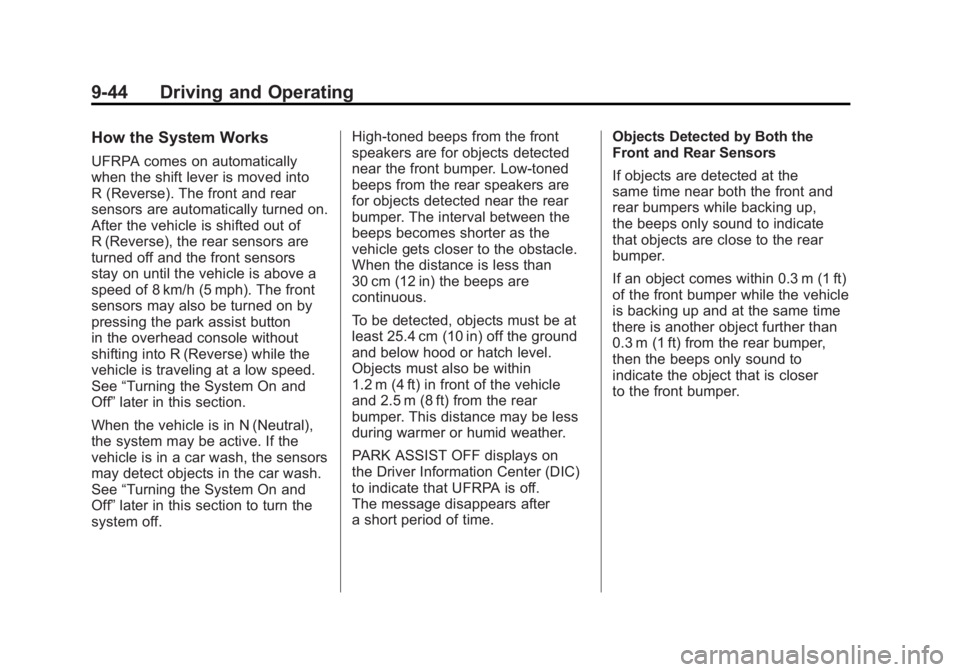
Black plate (44,1)Chevrolet Volt Owner Manual - 2011
9-44 Driving and Operating
How the System Works
UFRPA comes on automatically
when the shift lever is moved into
R (Reverse). The front and rear
sensors are automatically turned on.
After the vehicle is shifted out of
R (Reverse), the rear sensors are
turned off and the front sensors
stay on until the vehicle is above a
speed of 8 km/h (5 mph). The front
sensors may also be turned on by
pressing the park assist button
in the overhead console without
shifting into R (Reverse) while the
vehicle is traveling at a low speed.
See“Turning the System On and
Off” later in this section.
When the vehicle is in N (Neutral),
the system may be active. If the
vehicle is in a car wash, the sensors
may detect objects in the car wash.
See “Turning the System On and
Off” later in this section to turn the
system off. High-toned beeps from the front
speakers are for objects detected
near the front bumper. Low-toned
beeps from the rear speakers are
for objects detected near the rear
bumper. The interval between the
beeps becomes shorter as the
vehicle gets closer to the obstacle.
When the distance is less than
30 cm (12 in) the beeps are
continuous.
To be detected, objects must be at
least 25.4 cm (10 in) off the ground
and below hood or hatch level.
Objects must also be within
1.2 m (4 ft) in front of the vehicle
and 2.5 m (8 ft) from the rear
bumper. This distance may be less
during warmer or humid weather.
PARK ASSIST OFF displays on
the Driver Information Center (DIC)
to indicate that UFRPA is off.
The message disappears after
a short period of time.
Objects Detected by Both the
Front and Rear Sensors
If objects are detected at the
same time near both the front and
rear bumpers while backing up,
the beeps only sound to indicate
that objects are close to the rear
bumper.
If an object comes within 0.3 m (1 ft)
of the front bumper while the vehicle
is backing up and at the same time
there is another object further than
0.3 m (1 ft) from the rear bumper,
then the beeps only sound to
indicate the object that is closer
to the front bumper.
Page 347 of 516
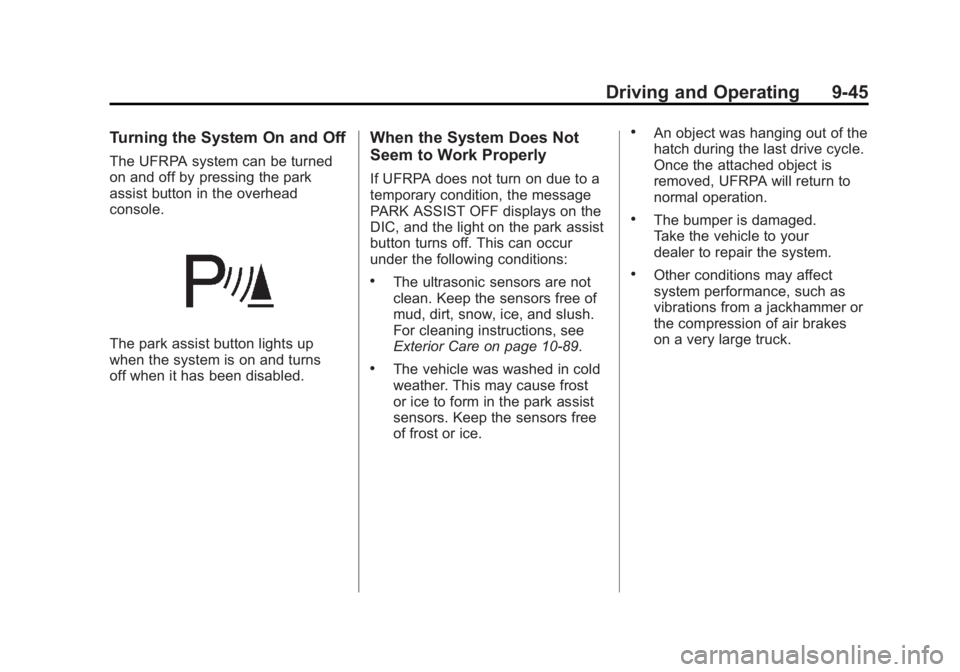
Black plate (45,1)Chevrolet Volt Owner Manual - 2011
Driving and Operating 9-45
Turning the System On and Off
The UFRPA system can be turned
on and off by pressing the park
assist button in the overhead
console.
The park assist button lights up
when the system is on and turns
off when it has been disabled.
When the System Does Not
Seem to Work Properly
If UFRPA does not turn on due to a
temporary condition, the message
PARK ASSIST OFF displays on the
DIC, and the light on the park assist
button turns off. This can occur
under the following conditions:
.The ultrasonic sensors are not
clean. Keep the sensors free of
mud, dirt, snow, ice, and slush.
For cleaning instructions, see
Exterior Care on page 10‑89.
.The vehicle was washed in cold
weather. This may cause frost
or ice to form in the park assist
sensors. Keep the sensors free
of frost or ice.
.An object was hanging out of the
hatch during the last drive cycle.
Once the attached object is
removed, UFRPA will return to
normal operation.
.The bumper is damaged.
Take the vehicle to your
dealer to repair the system.
.Other conditions may affect
system performance, such as
vibrations from a jackhammer or
the compression of air brakes
on a very large truck.
Page 348 of 516
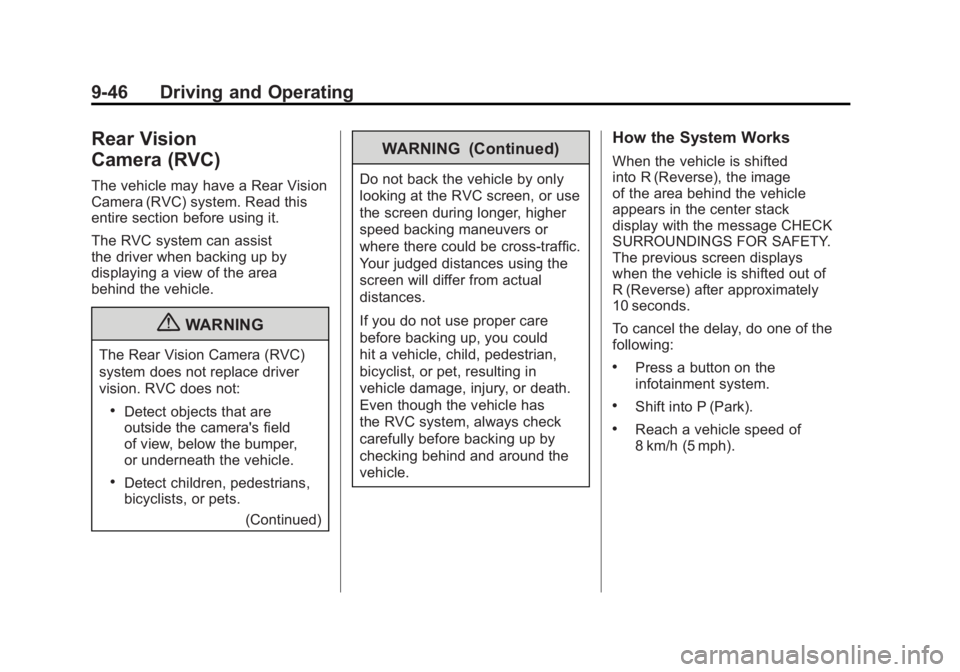
Black plate (46,1)Chevrolet Volt Owner Manual - 2011
9-46 Driving and Operating
Rear Vision
Camera (RVC)
The vehicle may have a Rear Vision
Camera (RVC) system. Read this
entire section before using it.
The RVC system can assist
the driver when backing up by
displaying a view of the area
behind the vehicle.
{WARNING
The Rear Vision Camera (RVC)
system does not replace driver
vision. RVC does not:
.Detect objects that are
outside the camera's field
of view, below the bumper,
or underneath the vehicle.
.Detect children, pedestrians,
bicyclists, or pets.(Continued)
WARNING (Continued)
Do not back the vehicle by only
looking at the RVC screen, or use
the screen during longer, higher
speed backing maneuvers or
where there could be cross-traffic.
Your judged distances using the
screen will differ from actual
distances.
If you do not use proper care
before backing up, you could
hit a vehicle, child, pedestrian,
bicyclist, or pet, resulting in
vehicle damage, injury, or death.
Even though the vehicle has
the RVC system, always check
carefully before backing up by
checking behind and around the
vehicle.
How the System Works
When the vehicle is shifted
into R (Reverse), the image
of the area behind the vehicle
appears in the center stack
display with the message CHECK
SURROUNDINGS FOR SAFETY.
The previous screen displays
when the vehicle is shifted out of
R (Reverse) after approximately
10 seconds.
To cancel the delay, do one of the
following:
.Press a button on the
infotainment system.
.Shift into P (Park).
.Reach a vehicle speed of
8 km/h (5 mph).